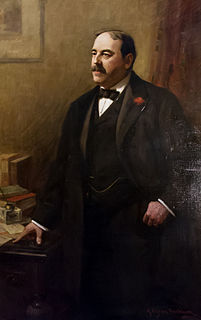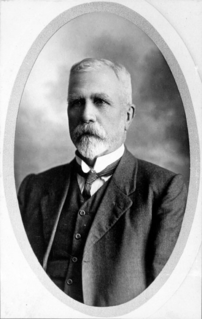Related Research Articles

James Bruce, 8th Earl of Elgin and 12th Earl of Kincardine, was a British colonial administrator and diplomat. He served as Governor of Jamaica (1842–1846), Governor General of the Province of Canada (1847–1854), and Viceroy of India (1862–1863). In 1857, he was appointed High Commissioner and Plenipotentiary in China and the Far East to assist in the process of opening up China and Japan to Western trade. In 1860, during the Second Opium War in China, he ordered the destruction of the Old Summer Palace in Beijing, an architectural wonder with immeasurable collections of artworks and historic antiques, inflicting incalculable loss of cultural heritage. Subsequently, he compelled the Qing dynasty to sign the Convention of Peking, adding Kowloon Peninsula to the British crown colony of Hong Kong.

Robert Charles Winthrop was an American lawyer and philanthropist, who served as the speaker of the United States House of Representatives. He was a descendant of John Winthrop.

Sir John Houblon was the first Governor of the Bank of England from 1694 to 1697.

Thomas Willing was an American merchant, politician and slave trader who served as mayor of Philadelphia and was a delegate from Pennsylvania to the Continental Congress. He also served as the first president of the Bank of North America and the First Bank of the United States. During his tenure there he became the richest man in America.

Joseph Albert Wright was the tenth governor of the U.S. state of Indiana from December 5, 1849, to January 12, 1857, most noted for his opposition to banking. His positions created a rift between him and the Indiana General Assembly who overrode all of his anti-banking vetoes. He responded by launching legal challenges to the acts, but was ruled against by the Indiana Supreme Court. The state's second constitutional convention was held during 1850–1851 in which the current Constitution of Indiana was drafted. He was a supporter of the new constitution and gave speeches around the state urging its adoption. He was opposed throughout his term by Senator Jesse D. Bright, the leader of the state Democratic Party.

Mark Joseph Carney is a Canadian economist and banker who served as the governor of the Bank of Canada from 2008 to 2013 and the governor of the Bank of England from 2013 to 2020. Since October 2020, he is vice chairman and head of Impact Investing at Brookfield Asset Management. He was the chair of the Financial Stability Board from 2011 to 2018. Prior to his governorships, Carney worked at Goldman Sachs as well as the Department of Finance Canada.

William Gregory was an American politician who served as the 46th Governor of Rhode Island.

Elisha Harris of Coventry, Kent County, Rhode Island, was Lieutenant Governor of Rhode Island, 1846–47 serving under Governor Byron Diman and the 20th Governor of Rhode Island 1847–49.

William Lennon was a politician in Queensland, Australia. He was a Member of the Queensland Legislative Assembly and a Member of the Queensland Legislative Council. He was Lieutenant-Governor of Queensland.
William Middleton Campbell (1849–1919) was Governor of the Bank of England from 1907 to 1909.
Abraham Houblon was Governor of the Bank of England from 1703 to 1705. He had been Deputy Governor from 1701 to 1703. He replaced John Ward and was succeeded by James Bateman.
Sir James Bateman was an English merchant and politician who sat in the House of Commons from 1711 to 1718. He became Lord Mayor of London and Governor of the Bank of England.
Edward Payne was Governor of the Bank of England from 1771 to 1773. He had been Deputy Governor from 1769 to 1771. He replaced William Cooper as Governor and was succeeded by James Sperling. Payne's tenure as Governor occurred during the Bengal bubble crash (1757–1769) and the Crisis of 1772.
James Sperling was Governor of the Bank of England from 1773 to 1775. He had been Deputy Governor from 1771 to 1773. He replaced Edward Payne as Governor and was succeeded by Samuel Beachcroft. Sperling's tenure as Governor occurred during the Bengal bubble crash (1769–1784).
Samuel Beachcroft was an English banker, Governor of the Bank of England from 1775 to 1777. He had been Deputy Governor from 1773 to 1775. He replaced James Sperling as Governor and was succeeded by Peter Gaussen. Beachcroft's tenure as Governor occurred during the Bengal bubble crash (1769–1784).
Cornelius Buller was an English banker who served as Governor of the Bank of England from 1824–26. He had been Deputy Governor from 1822 to 1824. He replaced John Bowden as Governor and was succeeded by John Baker Richards. Buller's tenure as Governor occurred during the Panic of 1825.

Richard Mee Raikes (1784–1863) was an English banker, Governor of the Bank of England from 1833 to 1834. He had been Deputy Governor from 1832 to 1833. He replaced John Horsley Palmer as Governor and was succeeded by James Pattison. He was bankrupted in 1834.
Timothy Abraham Curtis was Governor of the Bank of England from 1837-39. He had been Deputy Governor from 1834-37. He replaced James Pattison as Governor and was succeeded by John Reid. Curtis' tenure as Governor occurred during the Panic of 1837. In June 2020, the Bank of England issued a public apology for the involvement of Curtis, amongst other employees, in the slave trade following the investigation by the Centre for the Study of the Legacies of British Slave-ownership at UCL.
William Robinson was Governor of the Bank of England from April to August 1847. He had been Deputy Governor from 1845 to 1847. He replaced John Benjamin Heath as Governor and was succeeded by James Morris. Robinson's tenure as Governor occurred during the Panic of 1847.
James Morris was Governor of the Bank of England from 1847 to 1849. He had been Deputy Governor in 1847. He replaced William Robinson as Governor and was succeeded by Henry James Prescot. Morris's tenure as Governor occurred during the Panic of 1847.
References
- ↑ Governors of the Bank of England. Archived 2012-02-12 at the Wayback Machine Bank of England, London, 2013. Archived here. Retrieved 22 March 2016.